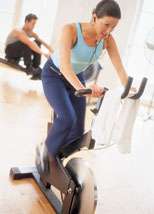Fitness
Find your care
At the UCLA Health Spine Center, our experts diagnose, manage and treat all spinal injuries and conditions. Call 310-319-3475 to connect with a spine specialist.
Fax: 424-259-6560
Fitness is a combination of body composition, muscular performance and cardiovascular fitness, with the latter being one of the most important components.
Improving cardiovascular performance increases your supply of oxygen and energy to your body. It also decreases your risk of heart disease, stroke, high blood pressure and other life- threatening diseases. Cardiovascular fitness can lead to prolonged endurance and will help you perform to your best abilities. When a heart is well conditioned, it is like any other muscle, it becomes stronger and more efficient. A normal heart beats at approximately 70 beats per minute at rest, but a conditioned heart may not beat more than 40 beats per minute. As you can see, a healthy heart has to work half as much to get the same amount of oxygen to your body.

Aerobic (meaning with oxygen) exercise involves steady, constant motion of the muscles, which increases the body's demand for oxygen. In this manner, aerobic exercise works your heart muscle, which makes it bigger and stronger. Examples of aerobic exercises are walking, running, swimming and cycling. While you want the exercise to be intensive, you don't want to overdo it. The best way to monitor the amount of work you are doing is to measure your heart rate by timing your pulse. A target heart range (THR) is 60-75 percent of 220 minus your age. While exercising, measure your heart rate frequently and increase your exercise to reach your THR, but if you start to exceed it, slow down.
At the beginning, aim for the low end of your THR, and as you become more fit, gradually work into the higher range. Exercising for 20-30 minutes, five times a week will help you become fit.
Make Fitness A Priority
Physical exercise should be given the same importance as any important event. Regardless of what exercise you choose, 20-30 minutes, 5 times a week should be placed into your routine schedule. Tips to fit exercise into your schedule are:
- Walk during your lunch hour or coffee break.
- Change social activities by getting together for a softball game, bicycle ride or a walk.
- Do a business exercise session rather than a business lunch.
- Pedal your way to fitness and enjoy the scenery and the company of family or friends on a bicycle.
Smoking is not considered good for your health.
Sneak Exercise Into Your Daily Routine
Increasing your physical activity doesn't always mean going to the gym. Try putting it into your daily routine. If you do this, you are more likely to keep doing it because you don't have to go out of your way to exercise. Some tips to improve your physical activity:
- Park your car further from your destination.
- Take stairs whenever possible.
- Hand-deliver messages rather than using the phone or e-mail.
- Hand wash your car instead of using a car wash.
- Take your dog for a walk twice a day. (The dog will benefit too!)
- Get up and change the television channel instead of using the remote control.